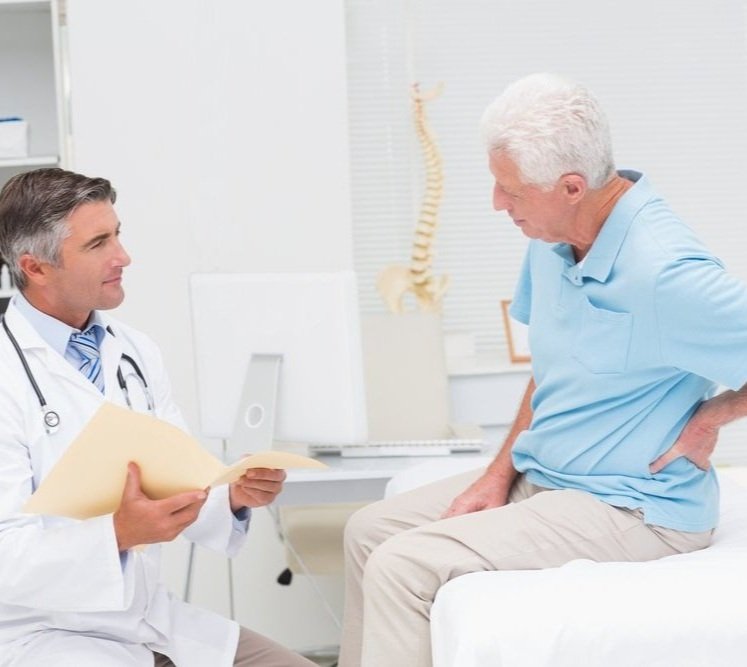Common Conditions that Cause Neck Pain
The neck, also called the cervical spine, is a marvelous and complex structure. But several problems can arise within the neck.
While most instances of neck pain can resolve themselves within a few days or weeks, some people develop a condition that needs to be treated for the pain to go away. Many times chiropractic care can help with these. In some cases, surgery may be required but there are typically several non-surgical options that can be tried first. Below are the most common conditions that are associated with neck pain.
Click on a specific neck pain condition below to learn more.
In addition to supporting the full weight of your head (roughly 12 pounds), the cervical spine is able to move in several directions. While this combination is amazing, it also leaves the neck susceptible to pain and injury.
Neck pain can be labeled as acute, subacute, and chronic.
Acute pain refers to neck discomfort that comes on suddenly due to something happening to you, such as an injury. This type of pain typically lasts less than 4 weeks.
Subacute pain typically lasts anywhere from 4 to 12 weeks.
Chronic neck pain is ongoing, often lasting 3 to 6 months or longer. Chronic pain is typically related to a medical condition, such as spine degeneration and autoimmune disorders.
There are many things that can cause pain in the neck – the most common being muscle strain, often brought on by poor posture and sleeping positions. Fortunately, there are steps that can be taken to prevent or relieve neck pain whether it’s acute, subacute or chronic. And it can often be treated with chiropractic care if addressed early, before surgery is necessary.
If you don’t take care of yourself, you could end up with a temporary or permanent disability that may make it hard to work or do everyday things.

Chiropractic Treatments for Neck Pain
Chiropractic care can be a very effective option for treating neck pain, often times, providing relief without surgery. A growing list of research studies and reviews demonstrate that the services provided by chiropractors are clinically effective, safe, and affordable.
Select one of the treatments below that are available at Village Chiropractic:
Related Read
How Chiropractic Care Can Help Neck Pain
Topics on Neck Pain
Common Neck Pain Conditions

Cervical Spondylosis (Arthritis Of The Neck)
Cervical spondylosis, also called cervical osteoarthritis and arthritis of the neck, refers to the wear-and-tear on the bones (vertebrae) and cartilage (discs) that make up your neck. It is a common cause of chronic neck pain that typically worsens as a person grows older.
Symptoms vary based on whether the person has been diagnosed with cervical or lumbar spondylosis. Symptoms can range from mild to severe and can develop gradually or occur suddenly. People with cervical spondylosis may experience common symptoms such as:
Neck pain and stiffness
Headaches
Grinding or popping noise when you turn your neck
Muscle weakness or spasms in the neck or shoulders
Pain in the shoulder, arm, or hand
The most common cause of cervical spondylosis is aging. Other causes and risk factors can include:
Abnormal spine movement, such as frequent overuse and strenuous activity
Genetics (family history of spondylosis)
Living a sedentary lifestyle
Smoking
Being obese
Prolonged sitting
Prior injury
Bulging Disc in the Neck
A bulging or protruding disc in the neck occurs when a spinal disc weakens and pushes on the cervical spine. It is considered to be “contained”, meaning the disc remains intact and mucoprotein gel inside has not leaked out.
Bulging discs in the neck don’t always cause pain since they generally do not protrude far enough to press on a nerve. When there is pain, however, it can affect your neck, shoulders, chest, and/or arms.
Common symptoms can include:
Muscle spasms
Tingling or pain in the fingers, hands, arms, neck, or shoulders
The most common cause of a bulging disc in the neck is aging. Discs may become more vulnerable over time. Other factors that can lead to a bulging disc include:
Living a sedentary lifestyle
Smoking
Being obese
Continuous strain from injury or heavy lifting
Weakened neck muscles
Improper body positioning during sitting, standing, sleeping, or exercising
Related Reading:
Common Causes Of Neck Pain And How Chiropractic Care Can Help
Cervical Herniated Disc
Cervical disc herniation occurs when a contained, bulging disc cracks, causing the inner fluid to protrude or leak. The herniated disc may press on your nerves or spinal cord. Herniated discs are often referred to by other names including slipped disc and ruptured disc.
Regardless of what they are called, disc conditions such as these can lead to nerve root irritation or compression, which can cause pain as well as other symptoms including:
Neck pain or stiffness
Headaches
Pain radiating from the neck down through the shoulder, arm, hand, and/or fingers (may feel hot or like an electrical shock)
Numbness, tingling, burning, and/or weakness radiating down into the shoulder, arm, hand, and/or fingers
Pain that is worse at night, after standing or sitting, or with certain movements
Herniated discs are usually caused by normal wear and tear that comes with aging. Over time, the outer ring of your intervertebral disc becomes weakened, allowing the inner disc to slip out of place. Factors that may increase your risk for developing a herniated, slipped, or ruptured discs are:
Wear and tear over time (degeneration)
Trauma
Smoking
Being obese
Weak neck muscles
Related Reading
Cervical Herniated Discs: Causes & Symptoms
Cervical Degenerative Disc Disease
Cervical degenerative disc disease is a common cause of pain in the neck and pain that radiates down the arm. This condition develops when the rubbery discs in the cervical spine begin to shrink and lose their cushing properties. This wear-and-tear on a cervical disc is a normal part of the aging process.
Degenerative disc disease of the neck is often indicated by a low-grade, continuous pain around the degenerating disc that occasionally flares up into more severe and sometimes debilitating pain. Other signs that might indicate cervical degenerative disc disease include, especially if it has lasted longer than six weeks include:
Sharp or electric shock-like nerve pain that can radiate down the shoulder into the arm, hand, and/or fingers
Tingling, numbness, and/or weakness that can radiate down the shoulder into the arm, hand, and/or fingers
Pain that worsens with movement
In most cases, age is a contributing factor of degenerative disc disease of the neck. However, not everyone who ages will develop this painful condition. Common causes and risk factors of this condition include:
Normal wear and tear from sports and daily activities
Loss of fluid that causes the center of the disc to dry out
Trauma or injury that causes swelling or soreness
Genetics
Being obese
Tobacco use
Cervical Spinal Stenosis
Cervical spinal stenosis is a medical condition in which the spinal canal narrows and compresses the nerves in your neck, causing chronic neck pain and pressure. If cervical spinal stenosis causes spinal cord compression, it may be referred to as cervical myelopathy. Cervical stenosis usually develops later in life, affecting people who are over the age of 50.
Some people with cervical spinal stenosis may not have symptoms. Others may experience:
Numbness or tingling in a hand, arm, foot and/or leg
Weakness in a hand, arm, foot and/or leg
Reduced fine motor skills, such as typing, buttoning a shirt, or putting a key in the door
Problems with walking and balance
Neck pain
In severe cases, bowel or bladder dysfunction (urinary urgency and incontinence)
Cervical spinal stenosis is most commonly caused by wear-and-tear changes in the spine related to osteoarthritis. However, there are other factors that can contribute to developing this condition, which include:
Bone spurs (overgrowth of bone)
Herniated discs
Thickened ligaments in the cervical spinal area
Tumors
Spinal injuries
Related Reading
4 Signs of Spinal Stenosis and How to Relieve the Pain Without Surgery
Headaches/Migraines With Neck Pain
Headaches can range from being mildly uncomfortable to being extremely painful and debilitating. The most incapacitating type of headache is called a migraine headache, which is characterized by intense pain as well as other troublesome symptoms. Many people who suffer from migraines feel tightness, stiffness or pain in their necks, either before or during an attack. In fact, a 2010 study showed neck pain was an even more common symptom than nausea.
Some neck-related symptoms that headaches and/or migraines may cause include:
Headache pain behind the eyes
Reduced range of neck movement
Pain located on one side of the head only
Tightness and stiffness in the neck
Pain that spreads from the back of the head and neck up to the front
Headaches that worsen when you apply pressure to certain parts of the neck
Headaches can be caused by various reasons, including:
A blow to the head of some kind
Skipping meals
Dehydration
Overindulging in alcohol or caffeine
Stress and/or anxiety
Sinus problems
Muscle strains
High blood pressure
Being subjected to loud noise for an extended period of time
Concussion
Stroke
Brain tumors
Various diseases or illnesses
Related Reading
What Is Causing My Neck Pain And Headache?
















